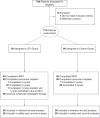Ulinastatin in the treatment of radiotherapy-induced oral mucositis in locoregionally advanced nasopharyngeal carcinoma: a phase 3 randomized clinical trial
- PMID: 40122906
- PMCID: PMC11930952
- DOI: 10.1038/s41467-025-57884-6
Ulinastatin in the treatment of radiotherapy-induced oral mucositis in locoregionally advanced nasopharyngeal carcinoma: a phase 3 randomized clinical trial
Abstract
Radiotherapy-induced oral mucositis (RTOM) is a common side effect of radiotherapy in locoregionally advanced nasopharyngeal carcinoma (LA-NPC) receiving concurrent chemoradiotherapy (CCRT). In this phase 3 trial, we aim to evaluate the efficacy and safety of Ulinastatin (UTI) for the prevention and treatment of RTOM in LA-NPC patients (NCT03387774). The primary endpoint is the incidence of grade ≥3 acute RTOM during radiotherapy. Secondary endpoints include cumulative incidence of RTOM, recovery rate, the onset time and duration of grade ≥3 RTOM, oral pain (severe), safety and survival outcomes. 179 eligible patients are randomly assigned to UTI Group (n = 89) or Control group (n = 90). All UTI group patients complete UTI treatment as planned, and both groups complete scheduled CCRT. The incidence of grade 3 RTOM is significantly lower in UTI group compared with control group (25.8% vs 41.1%, P = 0.030). The trial meet its prespecified primary endpoint. No Ulinastatin related adverse events are observed during treatment. The 3-year overall survival (OS), locoregional relapse-free survival (LRRFS), distant metastasis-free survival (DMFS) and progression-free survival (PFS) in UTI group and control group are similar between two groups. In this work, Ulinastatin can effectively reduce the severity of RTOM and oral pain without increasing toxicity and compromising survivals.
© 2025. The Author(s).
Conflict of interest statement
Competing interests: The authors declare no competing interests. Ethics approval: The study was approved by the Ethics Committee of Sun Yat-sen University Cancer Center (B2017-063-01-01) and registered on ClinicalTrials.gov, number NCT03387774.
Figures



Similar articles
-
Sequential induction chemotherapy plus intensity-modulated radiotherapy versus concurrent chemoradiotherapy in locoregionally advanced nasopharyngeal carcinoma: the three-year report of a phase II, single center, randomized, non-inferiority trial.Cancer Med. 2021 Jun;10(12):3886-3895. doi: 10.1002/cam4.3936. Epub 2021 May 6. Cancer Med. 2021. PMID: 33955190 Free PMC article. Clinical Trial.
-
Raltitrexed versus 5-fluorouracil with cisplatin and concurrent radiotherapy for locally advanced nasopharyngeal carcinoma: An open labeled, randomized, controlled, and multicenter clinical trial.Cancer Med. 2020 Sep;9(17):6166-6172. doi: 10.1002/cam4.3260. Epub 2020 Jul 12. Cancer Med. 2020. PMID: 32657029 Free PMC article. Clinical Trial.
-
A randomized, controlled phase II trial of maxillofacial and oral massage in attenuating severe radiotherapy-induced oral mucositis and lipid metabolite changes in nasopharyngeal carcinoma.Radiother Oncol. 2021 Oct;163:76-82. doi: 10.1016/j.radonc.2021.07.024. Epub 2021 Jul 31. Radiother Oncol. 2021. PMID: 34343545 Clinical Trial.
-
Induction chemotherapy for locally advanced nasopharyngeal carcinoma treated with concurrent chemoradiation: A systematic review and meta-analysis.Radiother Oncol. 2018 Oct;129(1):10-17. doi: 10.1016/j.radonc.2018.02.027. Epub 2018 Mar 16. Radiother Oncol. 2018. PMID: 29555182
-
The efficacy and safety of induction chemotherapy combined with concurrent chemoradiotherapy versus concurrent chemoradiotherapy alone in nasopharyngeal carcinoma patients: a systematic review and meta-analysis.BMC Cancer. 2020 May 6;20(1):393. doi: 10.1186/s12885-020-06912-3. BMC Cancer. 2020. PMID: 32375701 Free PMC article.
Cited by
-
Neuron-like macrophage differentiation via the APOE-TREM2 axis contributes to chronic pain in nasopharyngeal carcinoma.Cell Biol Toxicol. 2025 May 20;41(1):86. doi: 10.1007/s10565-025-10035-5. Cell Biol Toxicol. 2025. PMID: 40392335 Free PMC article.
References
-
- Chen, Y.-P. et al. Nasopharyngeal carcinoma. Lancet394, 64–80 (2019). - PubMed
-
- Al-Sarraf, M. et al. Chemoradiotherapy versus radiotherapy in patients with advanced nasopharyngeal cancer: phase ||| randomized Intergroup study 0099. J. Clin. Oncol.16, 1310–1317 (1998). - PubMed
-
- Chen, L. et al. Concurrent chemoradiotherapy plus adjuvant chemotherapy versus concurrent chemoradiotherapy alone in patients with locoregionally advanced nasopharyngeal carcinoma:a phase 3 multicentre randomised controlled trial. Lancet Oncol.13, 163–171 (2012). - PubMed
-
- Sun, Y. et al. Induction chemotherapy plus concurrent chemoradiotherapy versus concurrent chemoradiotherapy alone in locoregionally advanced nasopharyngeal carcinoma: a phase 3, multicentre, randomised controlled trial. Lancet Oncol.17, 1509–1520 (2016). - PubMed
-
- Zhang, Y. et al. Gemcitabine and cisplatin induction chemotherapy in nasopharyngeal carcinoma. N. Engl. J. Med.381, 1124–1135 (2019). - PubMed
Publication types
MeSH terms
Substances
LinkOut - more resources
Full Text Sources

